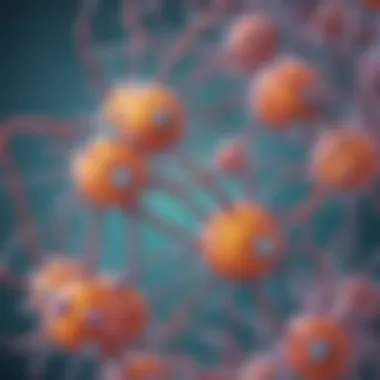Understanding Catalase: The Essential Biological Catalyst


Intro
Catalase is an important enzyme present in many living organisms. It helps in breaking down hydrogen peroxide, a harmful byproduct of cellular processes, into water and oxygen. This protective mechanism is necessary for maintaining cellular health as hydrogen peroxide can cause damage if it accumulates. Understanding catalase allows us to appreciate its crucial roles in various biological systems, which makes it worthy of investigation. This article will delve into various aspects of catalase, from its structure to its mechanisms of action and applications.
Science Fun Facts
- Catalase can break down millions of hydrogen peroxide molecules each second. This astounding speed makes it one of the most efficient enzymes in nature.
- The enzyme is found in multiple sources including potatoes, yeast, and even certain bacteria. This diversity is essential as different organisms rely on catalase for protection against oxidative stress.
- In a lab, catalase can be measured by the amount of oxygen it produces when acting on hydrogen peroxide. This can teach valuable lessons about enzymatic reactions.
- The discovery of catalase dates back to the late 19th century, and since then it has fascinated scientists for its role in detoxification processes.
Catalase is a vital enzymatic presence in nearly all aerobic organisms, contributing fundamentally to cellular protection and detoxification.
Discover the Wonders of Science
Science is full of fascinating concepts that can ignite curiosity. Catalase is just a starting point to explore a range of scientific ideas related to enzymatic activity, cellular metabolism, and biochemical pathways. Here are some ways to dive deeper into science:
- Educational Videos and Animations: Websites like YouTube have various informative videos that visually explain how enzymes like catalase function in real-time.
- Interactive Learning Tools: Platforms such as Khan Academy offer interactive lessons on enzymology and related fields that cater to young learners.
- Real-Life Applications of Science: Think about the mask production of hydrogen peroxide. It showcases the everyday relevance of catalase in mitigating harmful substances in our environment.
Science Quiz Time
Engaging quizzes can solidify understanding while making learning fun. Try these questions:
- What does catalase break down specifically?
- Catalase exhibits activity in which of the following:
- A) Glucose
- B) Hydrogen Peroxide
- C) Carbon Dioxide
- A) Only plants
- B) Only animals
- C) Both plants and animals
Science Experiment Showcase
Experiments can be a valuable way to experience science firsthand, particularly when exploring catalase. Here is a simple experiment you can conduct:
Materials List
- Fresh potato (which contains catalase)
- Hydrogen peroxide
- Clean container
Step-by-Step Instructions
- Cut the potato into small pieces.
- Pour a small amount of hydrogen peroxide into the container.
- Place potato pieces into the hydrogen peroxide.
- Observe the bubbles forming. These bubbles signal the breakdown of hydrogen peroxide by catalase.
Safety Tips and Precautions
- Always wear safety goggles when working with chemicals.
- Keep hydrogen peroxide away from your eyes and open wounds.
Through these sections, it is clear that catalase undergoes vital functions that enable cellular health, safety, and environmental stability. Understanding the interesting properties and implications of such enzymes can inspire curiosity and provoke thoughtful inquiry.
Prolusion to Enzymes
Enzymes play a crucial role in life processes. They help accelerate chemical reactions in living organisms. Understanding enzymes is essential to grasp how biological systems function efficiently. Without enzymes, many of the reactions necessary for life would proceed far too slowly or not at all. This article emphasizes the significance of catalase, an enzyme with a unique function in breaking down harmful hydrogen peroxide in cells.
In particular, catalysts, as biological enzymes, foster life-enhancing reactions. They enhance the speed of crucial transformation while maintaining specificity, which means they only interact with certain substrates. Therefore, enzymes must be studied closely to appreciate their central role in biology. Here, we focus on defining enzymes, their integral part in cell physiology, and particularly how catalase fits into this framework.
What are Enzymes?
Enzymes are essentially proteins that act as catalysts. A catalyst is a substance that increases the rate of a chemical reaction without undergoing permanent changes itself. Most enzymes are proteins made from long chains of amino acids. Enzymes are unique because they can recognize and bind substrates—molecules that undergo a change during a chemical reaction.
Some enzymes are highly specific, working with only one substrate. Others may act on a group of closely related substrates. The interaction between the enzyme and its substrate forms an enzyme-substrate complex, which lowers the activation energy needed for the reaction to occur. This complex is where the action happens, eventually creating products from the reactants.
The Role of Enzymes in Biological Reactions
Enzymes serve several essential functions:
- Speeding up reactions: This enhancement is vital for maintaining life. Without these, biological processes would be painfully slow.
- Lowering the energy required: Enzymes can allow a reaction to occur at lower temperatures, which is preferable in most living contexts.
- Facilitating complex processes: In particular, metabolic pathways involve multiple steps, and enzymes ensure that these steps happen quickly and efficiently.
Moreover, different factors impact enzyme activity, including temperature and pH levels. Each enzyme operates optimally under specific conditions. When conditions deviate from optimal levels, enzyme function may diminish.


Enzymes operate effectively within narrow ph and temperature ranges to maintain optimal function.
It’s also worth noting how enzymes' actions lead to vital processes like digestion, energy production, and biosynthesis. For instance, the breakdown of starches into sugars involves enzymes such as amylase. Understanding the role of enzymes provides a foundation for delving into specific enzymes like catalase and recognizing the impact they have on overall physiological health.
Catalase: An Overview
Catalase is a vital enzyme, prominently present in various living organisms. Understanding its role sheds light on essential biological processes. Catalase primarily functions to decompose hydrogen peroxide, a harmful byproduct of metabolism, into water and oxygen. This reaction is crucial for maintaining cellular health, protecting cells from oxidative damage.
Definition of Catalase
Catalase is an enzyme described as a catalyst that accelerates the conversion of hydrogen peroxide into water and oxygen. Found in many organisms, catalase works effectively under specific conditions, usually in cellular compartments like peroxisomes. Its unique molecular structure allows it to facilitate this reaction extremely fast, significantly contributing to homeostasis.
Discovery of Catalase
The discovery of catalase dates back to the late 19th century. Scientists, including the German chemist Hugo de Vries, played a key role in identifying this enzyme's function and characteristics. Through early experiments, researchers found that catalase could quickly break down hydrogen peroxide, highlighting its importance in biological contexts. The findings spurred further studies into enzymatic functions and how these proteins support life at a cellular level.
Structure of Catalase
The structure of catalase plays a pivotal role in its function as a biological catalyst. Understanding its arrangement is fundamental to appreciating how it operates at a molecular level. Catalase is an irreplaceable enzyme in many organisms, ensuring that harmful hydrogen peroxide does not accumulate. Its structure directly influences its activity and efficiency in decomposing this potential toxin.
Molecular Composition
Catalase is a complex enzyme, primarily made up of protein subunits. These subunits come together to form a remarkable three-dimensional shape. Each catalase molecule is composed of four similar protein chains, contributing to its quaternary structure.
Key Points on Molecular Composition:
- Heme Group: Each of the four polypeptide chains contains a heme group, which is crucial for catalase's function. This group contains iron, enabling it to interact with hydrogen peroxide.
- Proximity Effect: The spatial arrangement of these chains establishes the enzyme's active site. This allows catalase to effectively bind and convert substrates.
- Stability: The unique amine acid sequences within the chains result in high stability, making catalase robust under various conditions.
Active Sites and Their Function
The active sites of catalase are its primary operational zones, where substrate molecules are transformed into products. Catalase exhibits remarkable catalytic efficiency, with each molecule capable of breaking down millions of hydrogen peroxide molecules every second.
Functional Dynamics of Active Sites:
- Hydrogen Peroxide Binding: When hydrogen peroxide reaches the active site, the enzyme quickly facilitates its decomposition into water and oxygen.
- Reaction Mechanism: The reaction occurs in two stages. Initially, the heme group oxidizes hydrogen peroxide, creating a reactive intermediate. Then, this intermediate quickly decomposes, releasing water and oxygen. This step is critical. The rapid conversion allows cellular processes to continue without delay.
Catalase can process up to 40 million hydrogen peroxide molecules in just one second.
- Enzyme Regulation: The availability of the substrate and the cellular conditions can significantly impact the activity of catalase. Factors like temperature and pH play vital roles in enzyme function.
The structural composition and the effective action of active sites reflect catalase's adaptability and importance in biological systems. Recognizing these characteristics provides insight into the enzyme's functionality and its crucial role in protecting cells from oxidative stress.
Mechanism of Action
The mechanism of action of catalase is a critical aspect of how this enzyme operates in various biological systems. Catalase acts as a biological catalyst, enabling significant biochemical reactions that would normally happen at a much slower rate without its influence. Understanding the mechanics involved provides insight into why catalase is so essential for cell health and functioning.
Catalytic Cycle of Catalase
The catalytic cycle of catalase is a continuous process involving specific steps that transform substrates into products. During the cycle, enzymatic reactions occur in a series of transitions that ultimately lead to the conversion of hydrogen peroxide into water and oxygen. The process can outline several key phases:
- Binding: The enzyme catalase has specialized structures that bind hydrogen peroxide molecules.
- Decomposition: Once bound, catalase actively lowers the energy barrier, accelerating the breakdown of hydrogen peroxide. Exiting the cycle is the production of water and molecular oxygen, often illustrated by bubbling observed when hydrogen peroxide is applied to a wound.
- Recycling Enzyme: After its catalytic action, the enzyme returns to its original state, ready to start the process again.
Catalase can convert approximately 6 million hydrogen peroxide molecules every minute, showcasing its incredible efficiency.
Substrates and Products
In biochemistry, the terminology of substrates and products is crucial for clarity and understanding. Catalase primarily uses hydrogen peroxide as its substrate, which is a harmful byproduct of various metabolic processes in cells. Here’s a closer look at these components:
- Substrates: The key substrate for catalase is hydrogen peroxide (O2). This compound accumulates in tissues and can cause cell damage if not removed.
- Products: The enzymatic reaction produces water (O) and molecular oxygen (O2). This reaction plays an essential role in cellular respiration and provides safety from oxidative stress.
This specialization ensures that cells can efficiently manage potentially dangerous molecules, contributing greatly to maintaining health and stability in biological systems.
Importance of Catalase in Biological Systems


Catalase plays a crucial role in almost all living organisms. It acts as a biological catalyst, helping convert hydrogen peroxide into water and oxygen. This function is vital because hydrogen peroxide is a byproduct of various metabolic processes and can be harmful in high concentrations. If left unchecked, hydrogen peroxide can damage cells, proteins, and DNA. Thus, catalase is essential for cellular health and function.
Key Benefits of Catalase:
- Regulates Metabolisms: Catalase ensures that the level of hydrogen peroxide in the cell is maintained at a safe level. This regulation is important for proper metabolic activities.
- Increases Cellular Efficiency: By breaking down hydrogen peroxide rapidly, catalase helps cells function effectively without unnecessary interruptions.
Role in Cellular Respiration
Cellular respiration is the process by which cells convert nutrients into energy. During this process, oxygen is consumed, and hydrogen peroxide may form as a byproduct. Here, catalase is important. It ensures that this byproduct does not accumulate to toxic levels. By breaking hydrogen peroxide down, catalase protects the respiratory enzymes and processes, allowing the cell to maximize energy output efficiently.
Main Points:
- With catalase, the risk of oxidative damage during respiration is greatly reduced.
- Efficient energy production is supported since metabolic processes are not hindered by toxic byproducts.
Thus, catalase is integral to cellular respiration and energy metabolism.
Protection Against Oxidative Stress
Oxidative stress occurs when there is an imbalance between free radicals and antioxidants in the body. Excess hydrogen peroxide can contribute to this stress. Catalase’s action is vital in neutralizing this effect. When it converts hydrogen peroxide into water and oxygen, it prevents oxidative damage in cells. This protection is crucial for maintaining the overall health of the organism.
Catalase interacts with other enzymes and antioxidants to manage free radicals effectively. It works in conjunction with enzymes like superoxide dismutase and glutathione peroxidase to maintain a balanced oxidative state.
Key Contributions of Catalase:
- Reduces Complications: By preventing oxidative stress, catalase reduces the risk of illnesses associated with oxidative damage, such as cancer and aging-related diseases.
- Balances Antioxidants: Catalase supports the body's antioxidant system by preventing overaccumulation of harmful substances from normal cellular processes.
In summary, the ability of catalase to protect cells from oxidative stress is crucial for health and longevity.
Sources of Catalase
Understanding the sources of catalase is essential to appreciate its biological significance. Catalase does not exist in isolation; instead, it is found in a variety of living organisms, where it plays a crucial role in metabolic processes. This section will examine how catalase is distributed in nature and the natural sources that provide it to ecosystems.
Occurrence in Living Organisms
Catalase is primarily located in the cells of living organisms, especially those that are exposed to oxidative stress. It resides within cellular organelles known as peroxisomes, where harmful substances, such as hydrogen peroxide, are decomposed. High concentrations of catalase are often found in the liver cells of animals. For instance, human liver contains notably high levels of catalase, facilitating rapid detoxification of hydrogen peroxide generated during metabolic activities.
Other organisms also exhibit high catalase activity. For example, plants, specifically beans and potatoes, have catalase, enabling them to cope with oxidative stress resulting from photosynthesis. Microorganisms like bacteria and yeast also contain catalase, allowing them to survive in various environments where reactive oxygen species may be abundant.
Natural Sources of Catalase
Several natural sources provide catalase, reflecting its diverse roles across nature. These sources include:
- Animal Tissues: Many animal tissues, especially those in higher organisms, are rich in catalase.
- Plants: Many plants have developed complex mechanisms to break down physical and environmental stressors with the help of catalase.
- Certain Bacteria: Some bacteria are known to produce catalase, which allows them to thrive in hostile environments.
The presence of catalase in various sources highlights its vital function in managing oxidative stress and maintaining cellular health. Moreover, catalase production can be influenced by environmental conditions and genetic factors.
In addition, certain foods like fruits and vegetables can naturally increase catalase levels in the human body. Noteworthy sources include animal liver, potatoes, carrots and some species of algae. Overall, catalase's occurrence in such wide-ranging elements demonstrates its integral part in sustaining life through its protective properties against oxidative damage.
Catalase in Scientific Research
Catalase is not just an essential enzyme in the biological systems of living organisms; it plays a vital role in scientific research as well. Its unique properties and functionalities offer opportunities for valuable insights into biological processes and biochemical reactions. Researchers explore various aspects of catalase, seeking to benefit multiple fields.
Applications in Biochemistry
Catalase is a crucial part of biochemistry labs. Biochemists utilize it to study reaction mechanisms and enzyme kinetics. By investigating catalase, they can understand how it interacts with hydrogen peroxide and other substrates.
- Study enzyme behavior: Scientists observe how catalase exhibits its protective role against hydrogen peroxide and minimize cell damage. This enables a deeper understanding of enzymes generally.
- Aid biosynthesis: In drug manufacturing, catalase helps in various reactions. This knowledge can streamline the process of producing medications and bioproducts.
The accumulation of findings related to catalase enriches the field of biochemistry by offering a clearer viewpoint of enzymatic processes.
Role in Diagnostic Testing
Catalase also showcases significance in diagnostic tests. Researchers value its properties for clinical applications. For instance, measuring catalase activity can help evaluate cellular function and health.


Challenges and Limitations
Understanding the challenges and limitations of catalase is crucial for appreciating its role in various biochemical processes. Factors influencing its activity can alter how effectively this enzyme assists in breaking down hydrogen peroxide. This can impact not only biological functions in living organisms but also its applications in research and industry.
Factors Affecting Catalase Activity
Several elements can determine the activity of catalase, impacting how well it performs its role. Here are some significant factors:
- Temperature: Catalase tends to function best within a specific temperature range. Extreme cold may decrease enzyme activity, while very high temperatures can denature the protein. This denaturation affect its structure and function.
- pH Level: Similarly, the activity of catalase can be affected by the pH of the environment. Optimal functioning occurs at a neutral pH. Deviations from this can hinder its activity, reducing its effectiveness in breaking down hydrogen peroxide.
- Substrate Concentration: The amounts of hydrogen peroxide present can also influence catalase activity. At low concentrations, the rate of reaction may not reach its full potential since there aren't enough reactants. However, at high concentrations, the reaction can saturate the enzyme's capacity.
- Presence of Inhibitors: Certain chemicals can inhibit catalase activity. These include heavy metals or organic compounds that interact unfavorably with the enzyme.
Understanding these factors is essential in both laboratories and natural contexts, to predict how catalase will function under varying conditions.
Enzyme Inhibition Mechanisms
Enzyme inhibition can significantly disrupt the activity of catalase, compelling researchers to fully understand these mechanisms. There are notably two categories of inhibition commonly encountered:
- Competitive Inhibition: In competitive inhibition, an inhibitor competes with hydrogen peroxide for binding at the active site. If the inhibitor successfully binds to the active site, the catalase cannot interact with hydrogen peroxide. This reduces the enzymatic activity.
- Non-competitive Inhibition: In contrast, non-competitive inhibition occurs when an inhibitor binds to an allosteric site, causing a change in the enzyme's shape that affects substrate binding. Even if hydrogen peroxide is present, catalase's functionality is inhibited as its active site may no longer effectively accommodate its substrate.
Recognizing these mechanisms is important. Knowing how to manage catalase activity means advancements in fields like biochemistry and industry applications can be realized. If inhibition is understood, tools and processes can be developed to control these effects purposefully, ultimately enhancing the use of catalase in various practical scenarios.
Understanding catalase's challenges helps in researching ways to optimize its usage.
Future Perspectives
The importance of exploring future perspectives on catalase lies in its potential impacts on health and technology. As a key enzyme with multiple biological functions, catalase may usher in new approaches to medical treatments and sustainable technologies. Understanding how catalase behaves and can be modified can pave the way for innovative solutions in biomedicine, agriculture, and environmental science.
Research Directions
Ongoing research is focused on better understanding catalase's specific roles in various biological processes. Some suggested research directions include:
- Genetic Regulation of Catalase: Understanding how genes regulate catalase production and its behavior under various conditions could lead to advances in genetic engineering.
- Catalase Variants in Different Species: Studying the enzyme in various organisms would give insights into evolutionary adaptations, potentially highlighting new functional properties.
- Enzyme Engineering: Modifying catalase for better performance in detoxifying harmful agents, such as hydrogen peroxide in pharmaceuticals, could enhance effectiveness and safety in treatments.
Exploring these directions allows scientists to connect catalase's basic science to applied IRL outcomes, which is valuable for academia and industry alike.
Potential Innovations in Biotechnology
Catalase's significance in biotechnology markets future innovations that may change current industry practices. Some possible innovations include:
- Biocatalysts in Industrial Processes: Utilizing catalase for reducing waste in chemical processes can lead to greener manufacturing practices, making industries more sustainable.
- Therapeutic Applications: Catalase can be pivotal in developing therapies aimed at oxidative stress-related diseases, like Alzheimer’s and cancer, combining traditional and modern medicines.
- Food Preservation: Using catalase in food storage could extend shelf life and reduce reliance on preservatives, responding to consumer demand for healthier options.
In summary, the future of catalase engagement promises multiple benefits that touch upon health, sustainability, and innovation---underscoring the thriving relationment between science and society.
The strides made through catalase research might transform numerous fields, empowering healthier living and scientific raspbenefits.
Closure
The conclusion provides an essential wrap-up to the discussions within this article on catalase, encapsulating the complex roles this enzyme plays across various biological systems. Its importance cannot be overstated, as catalase is a fundamental player in cellular health and protection from oxidative damage.
First, summarizing key components brings clarity. We learned that catalase is not just an ordinary enzyme. It serves as a catalyst that accelerates the breakdown of hydrogen peroxide into water and oxygen. This reaction is vital for preventing cellular damage, thus promoting longevity and health at a cellular level.
Next, the benefits of understanding catalase lies in its applications. From scientific research to health industries—these insights aid further innovations. Understanding catalase can open doors to new therapeutic options for oxidative stress-related diseases.
Finally, we must acknowledge some considerations involved. There is ongoing research on factors influencing its activity as well as mechanisms inhibiting its function. This awareness further enriches our understanding and guides future research priorities.
"Catalase stands as a beacon in understanding biological processes crucial to life."
This synthesis allows us to appreciate the nuanced existence of catalase in various environments and its potential to impact health significantly. Thus, encouraging curiosity about such knowledge benefits us all—enabling informed decisions regarding health and fostering a rich scientific understanding.
Summary of Key Points
- Catalase is a vital enzyme that breaks down hydrogen peroxide, preventing cellular damage.
- It significantly impacts cellular health, especially in human biological systems.
- The enzyme's activity can be influenced by various factors, indicating the need for ongoing research.
- Knowing about catalase can lead to advancements in medical treatments and scientific applications.
Encouraging Curiosity in Science
Instilling curiosity in science is crucial for younger generations. By highlighting the fascinating properties of catalase, we can motivate children, parents, and caregivers.
Encouraging exploration can take many forms:
- Engage with experiments: Simple demonstrations show how catalase works, for instance, using potato extract to observe bubble formation when exposed to hydrogen peroxide.
- Conversations around relevance: Discuss how catalase functions in everyday life, maintaining health or preventing aging. .Getting involved in science outside of school fosters critical thinking and promotes a lifelong appreciation for learning. Children are more inspired when they understand why something matters alongside how it works. In bringing catalase into that conversation, we can deepen their understanding and spark their imagination about the biochemistry of life.







